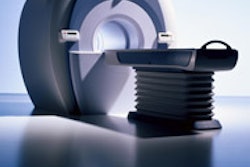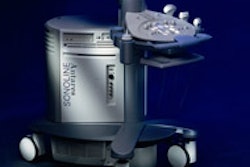We've all seen the pictures of floor polishers buried in the bores of magnets, the shattered remains of coils or phantoms scattered around. We know that 50 lb of steel can easily cause tens of thousands of dollars of damage to an MRI unit. But did you know that mere tablespoons of rust can cause similar damage?
The University of Alberta Hospital in Alberta, Canada, was on the brink of learning this the hard way. Fortunately, through persistent problem-solving, they prevented significant damage to their brand new MRI system, and also developed a set of tools that any facility can implement to protect their magnets.
The problem started in the magnet's cooling loop, a less-than-sexy part of an MRI unit that circulates chilled water from a chiller unit (often located in the equipment room) to a heat exchanger at the cold head on the magnet. Contaminate in this garden-hose-size pipe, initially blamed on pipe-grease or leftover construction residue, led to the failure of the magnet's cold head.
The cold head failure, and the roughly $17,000 (U.S.) replacement, triggered a three-year odyssey for Doug Dunn, the hospital's manager of building operations. What Dunn and the staff at the facility uncovered was a combination of poor maintenance coordination by the vendor, unexpected ferrous components in a critical MRI system, and a fair amount of "it's not my problem" posturing.
The chilled water loop specified by the MRI vendor was -- as you would expect -- to have no ferrous steel components. Now, ferrous pipes and pumps are used all the time in chilled water loops throughout hospitals, except MRI suites, to provide efficient cooling for large facilities. Rust in these systems is kept to a minimum because there isn't (or shouldn't be) any air in the pipes. Additionally, no air means no chance of the oxidation process harming the steel components.
In one of two new MRI units at the hospital, after the cold head failure, Dunn had a filter and view glass installed in the chilled water line so the hospital's engineering department could monitor the system. Much to their surprise, in a system that is supposed to have neither ferrous material nor air, they began detecting significant quantities of rust floating through the chilled water.
It turned out that the vendor was wrong. The pump in the chiller unit had a ferrous steel casing. It also turned out that the vendor's magnet techs had drained off water from the cooling loop without consulting the hospital's engineering staff, entraining rust-causing air into the system.
There was a great deal of back-and-forth finger pointing, but Dunn's methodical analysis revealed both the problem and the solution.
The short-term fix of installing a barrier filter, the same idea as a furnace filter or vacuum cleaner bag, was not the best solution. As the filter got clogged with debris, the flow of cold water slowed down. This is critical because the chilled water is used to remove the heat that would otherwise build up in the MRI system and eventually cause the cryogens to boil off (quench).
The engineering staff at the hospital, in concert with the project design engineers, designed a nonferrous stainless-steel mechanical separator approach to be retrofitted into the chilled water loop serving the MRI. This retrofit cost about $9,000 to install, but has extracted somewhere around 100 cc of particulate that was contaminating the system.
The facility has subsequently retrofitted all of their MRI units with mechanical separators, and has worked out a strict accord with the vendor that they will not touch the chilled water loop serving the magnet without one of the hospital's engineers present.
Did the initial cold head failure come from pipe grease or other construction-related causes, or from rust particulate held fast in the chilled water line at the cold head by the magnetic force of the MRI? The damaged part was taken by the vendor and, as far as the hospital knows, never analyzed. What they do know is that the amount of contamination ultimately filtered from the chilled water loop was well above the thresholds set by the manufacturer, and would have eventually caused a failure of the cold head and potentially other components.
Today, through the use of their nonferrous stainless-steel "baby separator" and a little chemical treatment, the hospital's MRI chilled water loops are perfectly clean.
What can each of us learn from this snafu and apply at our facilities?
First, know your vendor's equipment -- even if the vendor doesn't! Be aware of all ferrous components in the MRI system, even if it's only a pump casing in the next room. Knowledge of these systems makes you an educated consumer, capable of troubleshooting problems with the vendor and evaluating their assessment of any problems.
Second, know your building systems. Unlike the initial suspicions of the vendor, the contamination in the chilled water loop was not from dirty initial supply water or pipe grease. By installing and monitoring a filtration system on the chilled water loop, the hospital was able to identify the source of the problem. They knew their system and what their staff did to it. When unexpected results appeared, they were armed with the information needed to go to the vendor and ask the questions that solved the problem.
Finally, know who services your equipment and what they don't know. Sometimes vendor technicians act as if the work they do is protected by a magician's code of ethics -- never reveal how a trick is done! If you have any question about the vendor tech's ability to service the equipment and its interface to building systems, insist on having someone there who you know knows the building's systems. It's your equipment. You paid a million or two to buy it, you should be confident that it's being maintained properly.
If you are going to shop for new MRI systems, sit down with the vendors you are considering. Tell them that you expect more than cut-and-paste design templates and specifications. Tell them that you want to know what's "under the hood" and how it works. Insist that your project design team and in-house engineering staff be involved throughout.
And if you have an MRI system that has gone through a couple of cold heads and the chilled loop has no filtration system, it's time to take the initiative. Check out the water quality and know exactly who has been working on the system and when.
The lesson is this: It's not only ferrous oxygen cylinders and wheelchairs that are threats to the operation of your MRI -- it could be a handful of rust that brings your system down. Consider the impact on both revenue and patient care, not to mention the thousands of dollars in repairs and weeks of staff time lost, that came from the repeated repairs to this one MRI system. Fortunately for the rest of us, there are many important lessons that can be taken from this example and directly applied at other facilities.
By Robert Junk and Tobias Gilk
AuntMinnie.com contributing writers
December 8, 2004
Reprinted from www.mri-planning.com/ by permission of the authors. If you would like more information on any aspect of MR facility design or safety, please contact Robert Junk or Tobias Gilk at Jünk Architects.
Related Reading
HIPAA compliance strategies for MR control rooms, October 26, 2004
The fire extinguisher in your MRI suite: will it save a life or take one? September 22, 2004
What your vendor may not have told you about magnetic contamination, July 27, 2004
Universal room design can mitigate change costs, May 16, 2003
Facility-planning implications of the new MRI safety guidelines, September 9, 2002
Copyright © 2004 Jünk Architects, PC



















